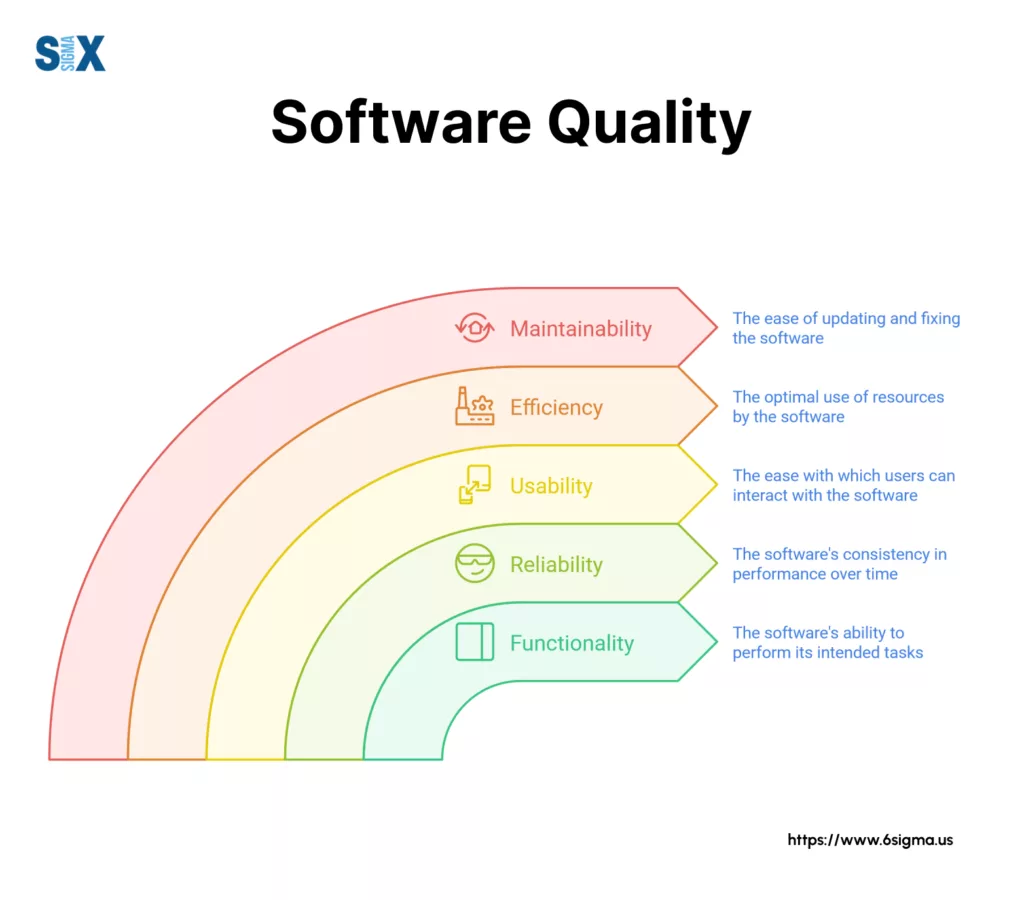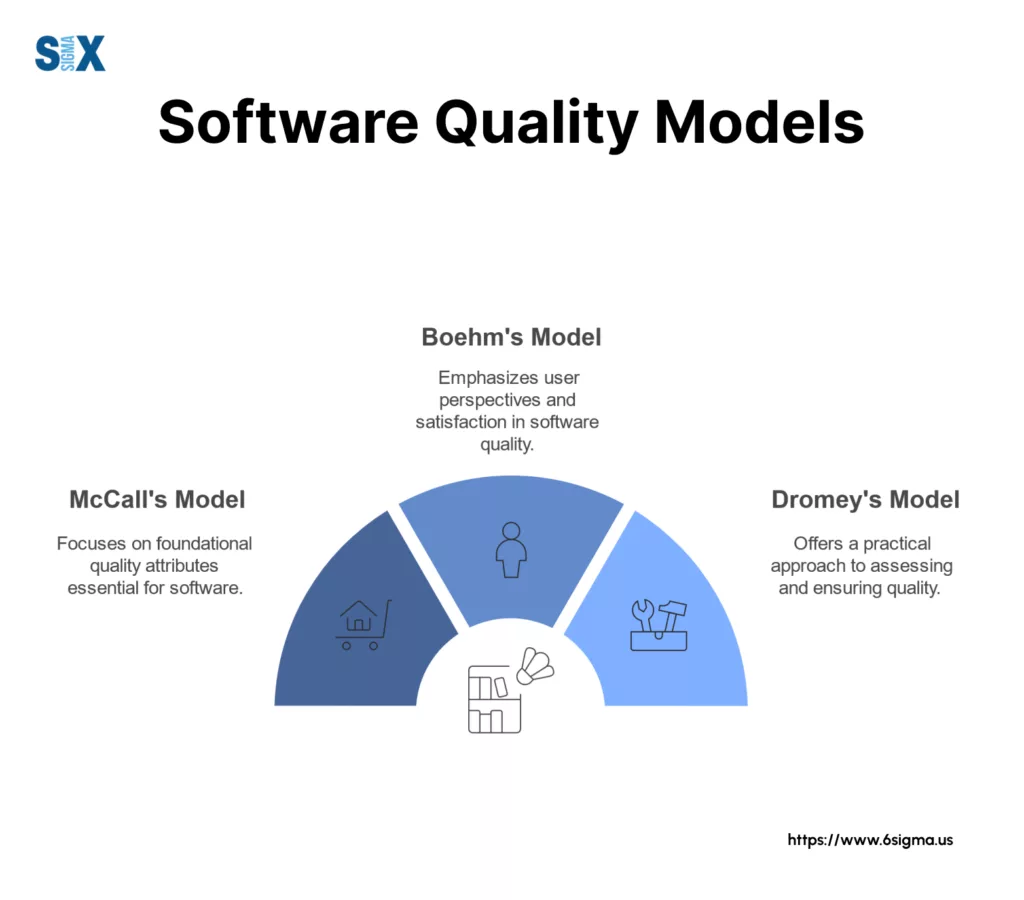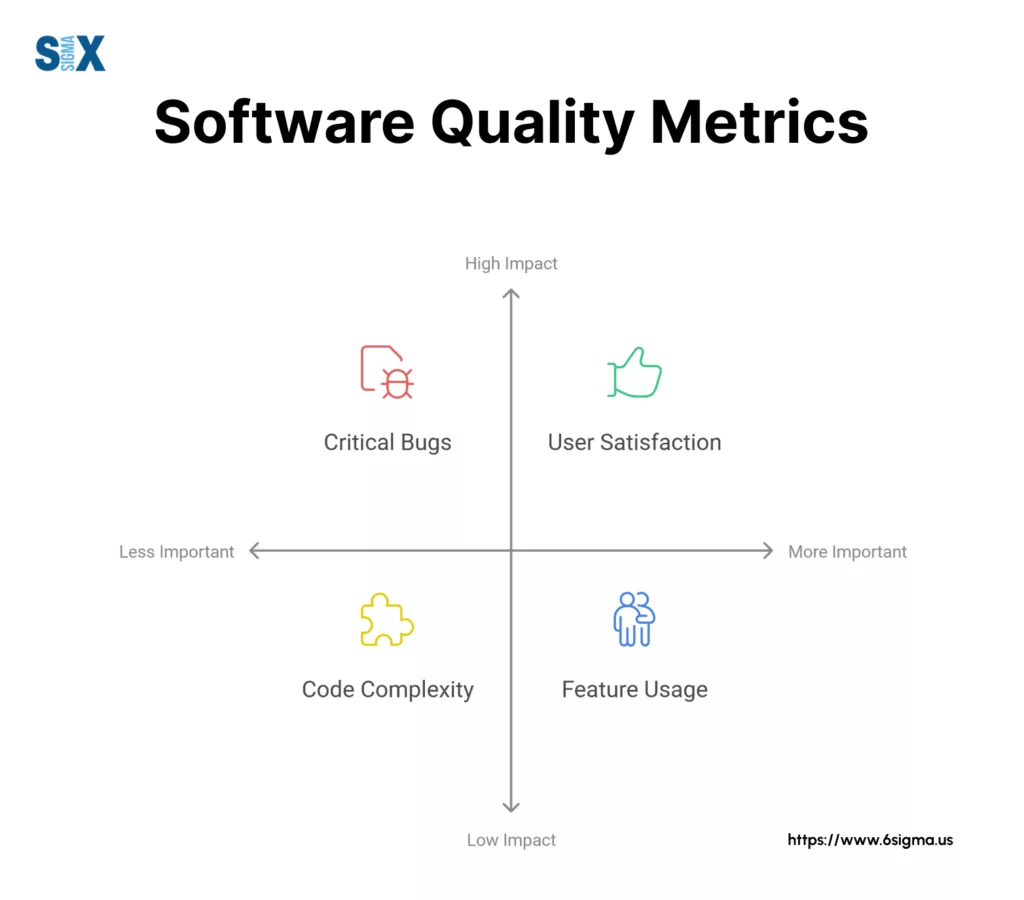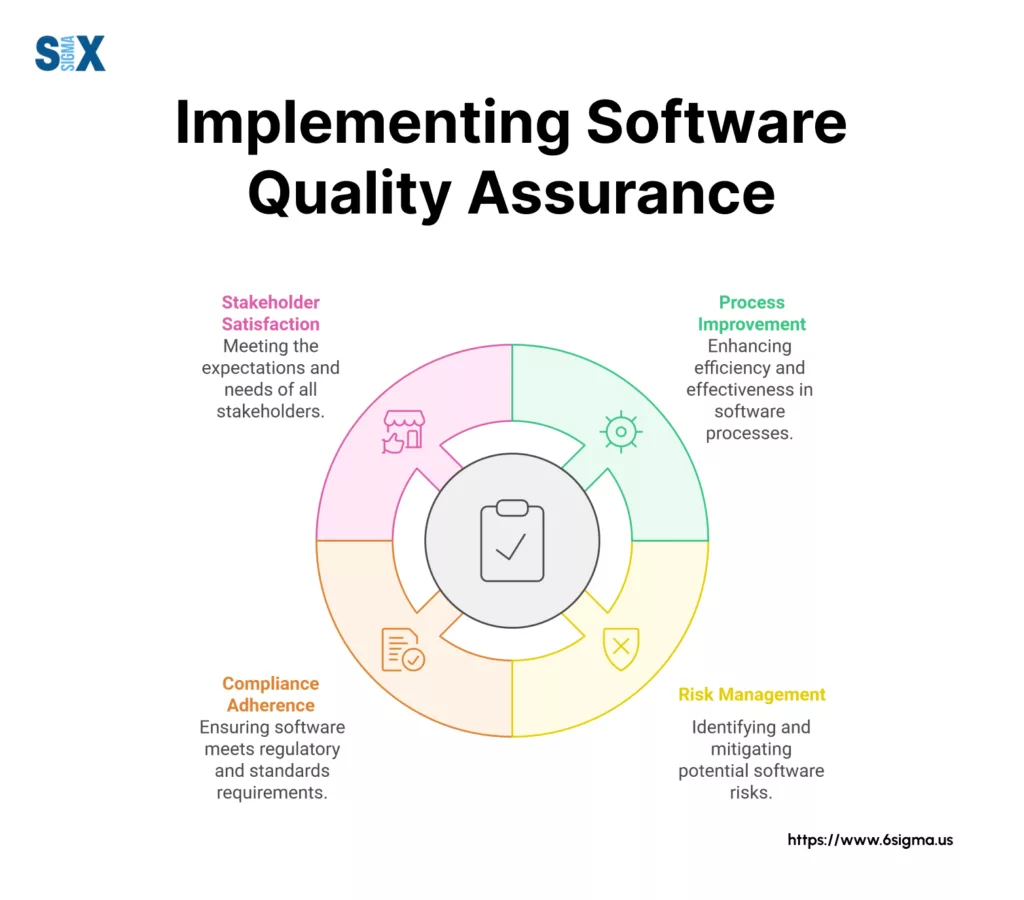The Guide to Software Quality: Definition, Metrics, and Best Practices
Software quality directly impacts your users’ experience, your team’s productivity, and your business’s bottom line. Quality isn’t just about catching bugs – it’s about creating software that delivers real value.
When we talk about software quality, we’re looking at how well your code meets both functional requirements and user expectations.
Think of it like building a house – it needs to be structurally sound (the functional part) but also comfortable and pleasant to live in (the user experience part).
What You’ll Learn About Software Quality
- Key dimensions that define software quality
- How to measure quality effectively
- Proven strategies to build quality into your development process
- Common pitfalls to avoid
- New trends shaping the future of software quality
What is Software Quality?
Building quality software means creating products that work reliably, perform well, and make users happy.

What Makes Software High Quality?
Software quality boils down to how well your product meets both stated requirements and user expectations.
The ISO/IEC 25010:2011 model gives us eight key dimensions of software quality in projects:
- Functional Suitability: Does your software do what it’s supposed to do? For example, if you’re building an e-commerce platform, can users actually complete purchases without errors?
- Performance Efficiency: How well does your software use resources? Nobody wants an app that drains their battery or takes forever to load.
- Compatibility: Does your software play nice with other systems? I once worked on a project that failed because we didn’t properly test integration with legacy systems.
- Usability: Can users easily figure out how to use your software? Good usability often means fewer support tickets and happier customers.
- Reliability: Does your software work consistently? Users need to trust that your system will be available when they need it.
- Security: How well does your software protect user data and resist attacks? One security breach can destroy user trust forever.
- Maintainability: Can developers easily fix bugs and add features? I’ve seen teams spend months untangling poorly maintained code.
- Portability: Can your software adapt to different environments? Users expect software to work across different devices and platforms.
Why Quality Matters To Your Bottom Line
Poor software quality hits both your users and your business hard.
- Users abandon software that frustrates them
- Support costs skyrocket from constant bug fixes
- Development slows as technical debt piles up
- Security breaches damage brand reputation
- Teams burn out fixing preventable issues
On the flip side, high-quality software:
- Builds user trust and loyalty
- Reduces long-term maintenance costs
- Makes teams more productive
- Gives you a competitive edge
- Supports business growth
The key is balancing these quality dimensions based on your specific needs.
Build a solid foundation in quality management! With Yellow Belt training implement effective quality processes in your software development.
Software Quality Models That Actually Work
Teams get lost trying to implement quality models. Let see what really works based on hands-on experience with different approaches.

McCall’s Quality Model: The Foundation
McCall’s model, while dating back to 1977, still offers valuable insights. Its three main perspectives particularly useful when explaining quality to stakeholders:
- Product Operation (how well does it run?)
- Product Revision (can we change it easily?)
- Product Transition (will it work in different environments?)
The model breaks these down into 11 factors that directly impact software quality.
Boehm’s Quality Model: The User’s Perspective
Boehm’s model puts users first – It focuses on:
- Utility (does it do what users need?)
- Maintainability (can we fix and improve it?)
- Portability (will it work everywhere needed?)
Dromey’s Quality Model: The Practical Approach
Dromey’s model takes a bottom-up view that resonates with developers. It links specific code properties to higher-level quality attributes.
This helps teams make better day-to-day coding decisions.
Picking The Right Model For Your Team
Here’s what choosing quality models brings you:
- Smaller teams often benefit from Dromey’s focused approach
- Enterprise projects might need McCall’s broader perspective
- User-centric products align well with Boehm’s model
The trick isn’t following one model perfectly – it’s taking what works for your situation.
Modern Takes On Quality Models
The development environment demands updates to these classic models.
For instance:
- Microservices architecture needs distributed quality metrics
- DevOps practices require continuous quality monitoring
- Cloud deployments introduce new reliability considerations
Measuring Software Quality: Metrics That Matter
Numbers tell stories about your software’s health. The right metrics help teams spot problems early and make informed decisions about quality improvements.

Essential Quality Metrics For Modern Software
Let’s examine the key metrics that reveal your software’s true quality:
Defect Density
- Number of bugs per thousand lines of code
- Lower numbers indicate better code quality
- Industry standard: 1-25 defects per KLOC
- Track trends over time for better insights
Code Coverage
- Percentage of code tested by automated tests
- Aim for 80% coverage in critical components
- Focus on meaningful tests, not just numbers
- Different coverage types: statement, branch, path
Cyclomatic Complexity
- Measures code path complexity
- Keep methods under 10 for maintainability
- Higher numbers indicate refactoring needs
- Tools like SonarQube track this automatically
Customer Satisfaction Scores
- Direct feedback from users
- Track support ticket patterns
- Monitor app store ratings
- Analyze user behavior metrics
Mean Time Between Failures (MTBF)
- Average time between system failures
- Higher numbers indicate better reliability
- Track by component and system-wide
- Set minimum thresholds for critical systems
Mean Time To Recover (MTTR)
- Time needed to fix issues
- Lower numbers show better maintenance
- Include detection and deployment time
- Critical for service level agreements
Setting Up Your Measurement Process
Follow these steps to implement effective quality measurements:
- Choose relevant metrics for your context
- Set up automated tracking tools
- Establish baseline measurements
- Define target ranges for each metric
- Create regular reporting schedules
- Train teams on metric interpretation
Taking Action On Quality Metrics
Raw numbers mean nothing without proper interpretation and action:
Warning Signs to Watch:
- Sudden spikes in defect density
- Declining code coverage
- Rising complexity scores
- Increasing MTTR values
Response Strategies:
- Schedule targeted refactoring sessions
- Improve test automation
- Update coding standards
- Enhance monitoring systems
- Invest in developer training
Remember these guidelines:
- Track trends over time, not just absolute values
- Consider context when interpreting metrics
- Focus on metrics that drive improvement
- Don’t optimize for metrics at the expense of actual quality
- Update measurement approaches as technology evolves
Modern development practices require additional considerations:
- Microservices: Track service-level metrics
- Cloud deployments: Monitor infrastructure metrics
- API-driven systems: Measure interface reliability
- Mobile apps: Track platform-specific metrics
Quality metrics should guide decisions, not dictate them. Use these measurements as tools to improve your software, not as mere checkboxes for compliance.
Make data-driven decisions with Statistical Process Control that transform raw metrics into actionable insights.
Implementing Software Quality Assurance That Works
Quality assurance transforms good software into excellent software.
The right implementation approach makes all the difference in achieving consistent, measurable results.

Building Your Quality Assurance Process
Start with requirements gathering and validation. Teams must define clear, testable requirements before development begins.
Next, create test plans that align with these requirements, ensuring coverage of both functional and non-functional aspects.
Set up version control and documentation standards early. This foundation supports consistent quality across the development lifecycle. Establish regular check-ins and milestones to track progress against quality goals.
Best Practices For High-Quality Software
Early and continuous testing catches issues when they’re cheapest to fix.
Run unit tests during development, integration tests during builds, and system tests before deployment. This layered approach prevents quality issues from reachin g production.
Code reviews and pair programming spread knowledge while catching defects. Teams should establish review guidelines focusing on both code quality and business logic.
Regular pairing sessions help junior developers learn from seniors while maintaining high standards.
Automated testing and continuous integration form the backbone of modern quality assurance.
Configure automated test suites to run with every code commit. Set up CI pipelines that reject builds failing quality checks. This automation ensures consistent quality standards across releases.
User feedback provides crucial insights for quality improvements. Implement feedback channels through beta testing, user surveys, and analytics. Use this data to guide feature development and bug fixes.
Overcoming Common Quality Challenges
Time pressure often leads teams to skip quality steps.
Combat this by automating repetitive tasks and incorporating quality checks into the development workflow. Make quality non-negotiable, even under deadline pressure.
Technical debt accumulates when teams prioritize speed over quality.
Schedule regular refactoring sessions and maintain a technical debt backlog. Address critical issues promptly to prevent cascading quality problems.
Resource constraints can limit quality initiatives. Focus on high-impact areas first and gradually expand quality processes. Leverage open-source tools and frameworks to reduce implementation costs.
Creating A Quality-First Culture
Organizations must prioritize quality from the top down. Leadership should demonstrate commitment through resource allocation and policy decisions. Regular training keeps teams updated on quality best practices.
Teams need clear quality metrics and goals. Establish benchmarks for code coverage, defect density, and customer satisfaction. Review these metrics regularly and adjust processes based on results.
Quality ownership belongs to everyone, not just QA teams. Developers should write tests for their code.
Product managers should include quality requirements in specifications. Operations teams should monitor quality metrics in production.
Modern development environments require adapted quality approaches. Microservices demand service-level quality monitoring.
Cloud deployments need infrastructure quality checks. Mobile applications require platform-specific quality considerations.
Software Quality in the Age of Modern Development
Agile methodologies reshape software quality through iterative development and constant feedback.
Daily standups, sprint reviews, and retrospectives create multiple checkpoints for quality validation. DevOps practices further enhance quality by bridging the gap between development and operations teams.
Quality gates in continuous delivery pipelines act as guardians of code quality.
Automated tests run at each stage, from commit to deployment, ensuring only high-quality code reaches production. These gates catch issues early, reducing the cost and impact of fixes.
The Speed vs. Quality Balance
Modern development demands rapid delivery without compromising quality. Smart automation helps achieve this balance.
Continuous integration servers run test suites automatically, while deployment automation reduces human error. Code analysis tools flag potential issues before they cause problems.
Static analysis, security scans, and performance tests run in parallel with development work. This concurrent quality checking maintains velocity while protecting standards.
Feature flags enable gradual rollouts, limiting the impact of potential quality issues.
Next-Generation Quality Assurance
AI-powered testing tools now detect patterns in code and predict potential failures.
Microservices architecture demands new quality approaches. Each service requires independent quality validation while maintaining system-wide standards.
Service contracts, API testing, and distributed tracing ensure quality across service boundaries.
Serverless applications bring unique quality challenges. Function testing, cold start performance, and integration validation become critical focus areas.
Cloud provider tools help monitor and maintain quality in serverless environments.
The Business Case for Software Quality
Investment in software quality yields measurable returns.
Early defect detection reduces fix costs by 100x compared to production fixes. Automated testing infrastructure pays for itself through reduced manual testing effort and faster release cycles.
Poor quality software bleeds money through extended development time, lost customers, and increased support costs.
Strategic Quality Investments
Quality investments must align with business goals. Critical systems demand higher quality investments than experimental features.
Risk analysis helps prioritize quality efforts where they matter most.
Moving Forward with Software Quality
Software quality evolves with technology advancement. Teams must stay current with quality practices while maintaining proven fundamentals. Automated testing, code reviews, and user feedback remain essential pillars of quality assurance.
Future quality practices will leverage AI, machine learning, and advanced analytics. Yet the goal remains unchanged: delivering reliable, efficient, and valuable software to users. Organizations that prioritize quality today position themselves for success tomorrow.
Start improving software quality now. Implement automated testing, establish quality metrics, and build a quality-focused culture.
Small steps toward better quality compound into significant improvements over time.
SixSigma.us offers both Live Virtual classes as well as Online Self-Paced training. Most option includes access to the same great Master Black Belt instructors that teach our World Class in-person sessions. Sign-up today!
Virtual Classroom Training Programs Self-Paced Online Training Programs







